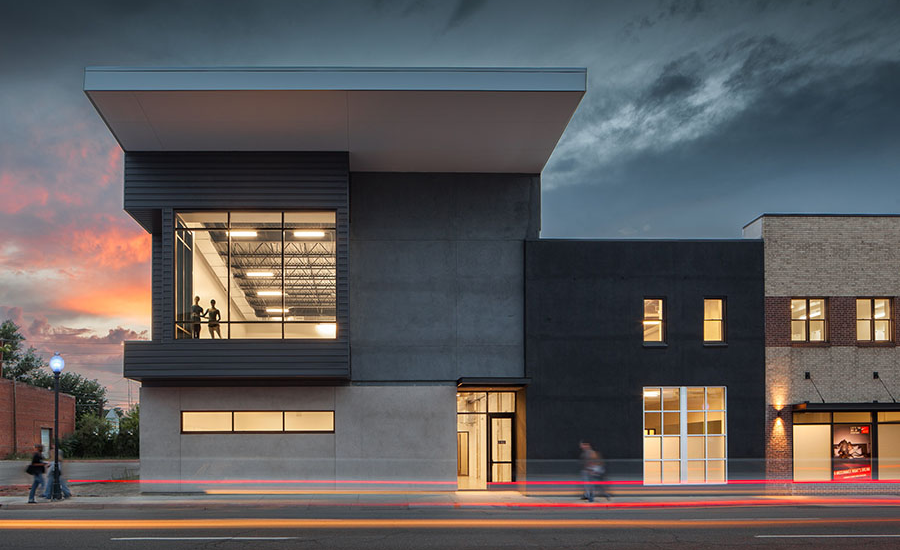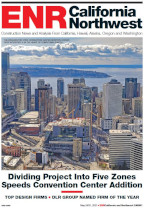The Armstrong Center for Dance, new home of the Colorado Ballet, recently won a 2015 Mayor’s Design Award in the preservation and adaptive reuse of historic buildings category. The Armstrong Center was honored during an Oct. 29 awards ceremony at the Ellie Caulkins Opera House.
“When I think about my original vision for our new space, and what we are now surrounded by, I’m thrilled to say that this is exactly what I envisioned for Colorado Ballet,” said Gil Boggs, the center’s artistic director. “We want Colorado Ballet to be in the national spotlight and our new building, The Armstrong Center for Dance is finally allowing us to fulfill that dream.”
The Colorado Ballet completed the long-awaited move into its new home at 1075 Santa Fe, on the north end of Denver’s Santa Fe Art District, in September 2014.
The ballet’s new space is comprised of eight studios—two the size of the Ellie Caulkins stage—as well as improved amenities for the company, including locker rooms and showers, a physical therapy and massage room to encourage wellness and prevent injuries and a shared staff and dancer lounge to foster greater interaction between them. The new location has safer student drop-off and increased parking in the neighborhood for academy families.
The new center also features a space that can be used as a studio and be converted to a community performance space for more intimate shows. The new Black Box Theater enables Colorado Ballet to add in-house productions to its repertoire, foster up-and-coming choreographers—both within the company and outside—and allow choreographers to practice their craft and present works to audiences.
The seven dedicated studios have increased and diversified the academy’s programming. Students now have opportunities to perform in the Black Box Theater for First Fridays and other occasions. Colorado Ballet’s new location represents a literal physical move, as well as a philosophical shift to a new place that’s more deeply embedded in the community. Also, the move from the ballet’s former home of 20 years in a leased space at Lincoln and 13thto the expansive new facility has helped to establish a center for dance in the state.
Design Intent
The architect for the new building was Denver’s Semple Brown Design and it was built by CMC Group.
Semple Brown designed the building with an abundance of glass and open views to allow the ballet to reach outward into the neighborhood rather than keep its art and activities within. The building’s approachable scale also allows the organization to better support its mission to educate the next generation of students through ballet academy programs and outreach.
“We are incredibly honored by and grateful for this award," said Chris Wineman, principal at Semple Brown. “The Armstrong Center for Dance was a decade-long labor of love for our firm. This project demanded the blending of three of our firm’s strengths: creative renovation of historic structures, performing arts architecture and placemaking at the neighborhood level. The opportunity to elevate the Colorado Ballet’s presence and impact on our city and state was one we took very seriously, thus recognition of this project by the city of Denver and Mayor Hancock means a great deal to us.”
Denver Mayor Michael Hancock and Brad Buchanan, executive director of Denver Community Planning and Development, presented award certificates to Sarah Semple Brown and Todd Afflerbaugh of Semple Brown, Gill Boggs, artistic director of Colorado Ballet, and ballet board members Merry Logan and Joanne Posner-Mayer.
A total of 16 projects were honored for excellence in architecture, design and placemaking during the annual awards ceremony.
According to the city of Denver, “Since 2005, the awards have been presented to Denver homeowners, business owners, nonprofits, artists and others for their creative contributions to the public realm through innovative design. Winners can range from community placemaking projects to adaptive reuse of historic structures to single-family residences to major mixed-use downtown buildings. Each brings something special to Denver’s unique visual fabric and speaks to our collective commitment to building healthy, sustainable communities.”
“With this year’s winning projects we have a little of everything that makes Denver Denver,” Hancock said. “That is, history, modernity, creativity, vitality and community. These property owners, community members and design professionals have done beautiful work that has improved our urban landscape.”



Post a comment to this article
Report Abusive Comment